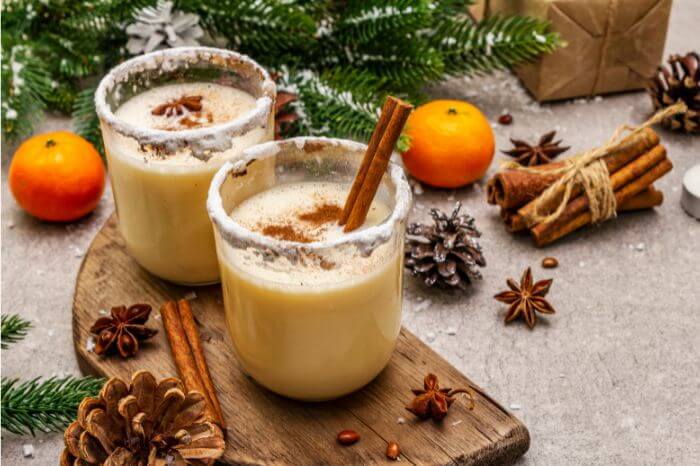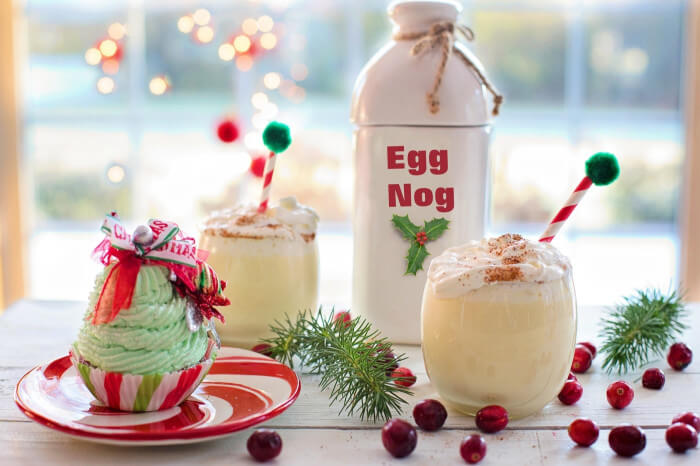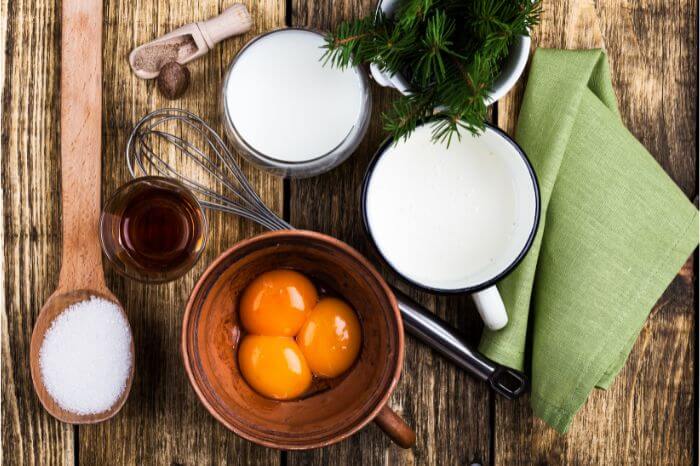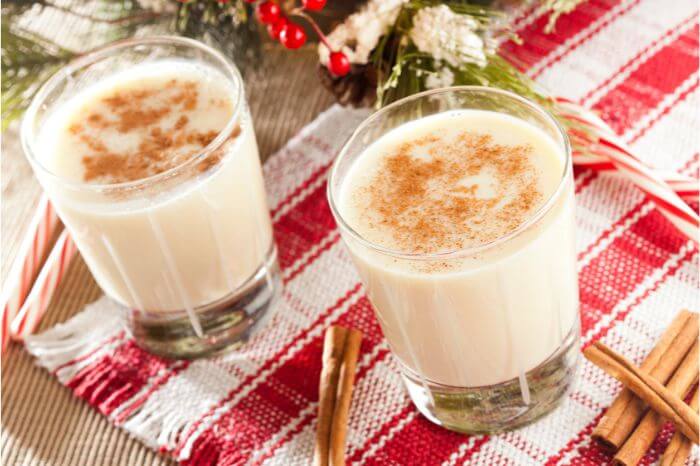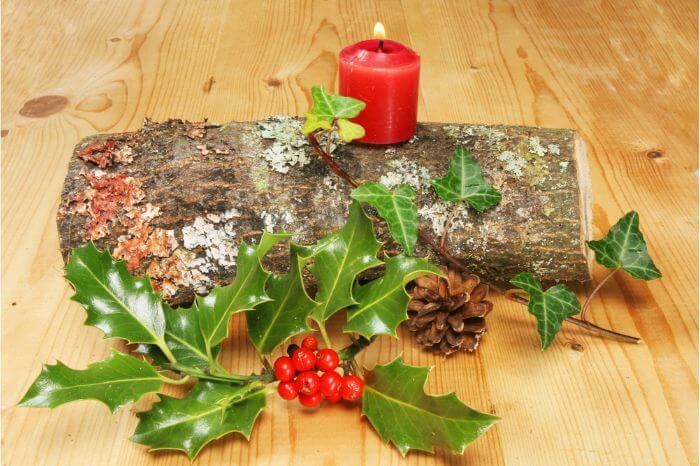Eggnog Origin and Traditions
As the holiday season approaches, we can’t help but get excited about all the festive traditions that come with it. One of our favorite holiday traditions is enjoying a cup of delicious eggnog. This creamy, spiced drink has become a staple of Christmas celebrations in many parts of the world, but have you ever wondered where it came from?
The origins of eggnog are shrouded in mystery, but most historians agree that it has its roots in medieval Britain. The drink was originally known as posset and was made by curdling hot milk with ale or wine.
Over time, eggs, sugar, and spices were added to the mix, transforming posset into the creamy, sweet eggnog we know and love today.
While the exact origins of eggnog may be unknown, one thing is certain: it has become an integral part of Christmas traditions around the world.
From cozy family gatherings to office parties and holiday markets, eggnog is a beloved holiday beverage that brings us all together. So let’s raise a glass of this delicious drink and toast to the holiday season!
History of Eggnog
When it comes to holiday drinks, eggnog is a classic that has been enjoyed for centuries. In this section, we’ll explore the origins of eggnog and how it has evolved over time.
Origins of Eggnog
The exact origins of eggnog are unclear, but it is believed to have originated in medieval Britain. According to some sources, eggnog was originally called posset, a hot, milky, ale-like drink that was often spiced and sweetened. As the recipe evolved, eggs were added to the mix, and the drink became known as egg-n-grog or eggnog.
Eggnog in Britain and American Colonies
Eggnog became popular in Britain in the 1700s, where it was often served at holiday parties and social gatherings. The drink made its way to the American colonies, where it became a popular Christmas drink, especially among the wealthy. George Washington is said to have served a version of eggnog that included rum, sherry, and brandy at his Mount Vernon estate.
Eggnog in Europe
Eggnog was also enjoyed in Europe, where it was often served as a dessert. In France, eggnog was known as lait de poule, or “hen’s milk,” and was made with eggs, milk, and sugar. In Germany, eggnog was called biersuppe, or “beer soup,” and was made with beer, eggs, and spices.
Eggnog in Puerto Rico and Mexico
Eggnog also made its way to Puerto Rico and Mexico, where it became a popular holiday drink. In Puerto Rico, eggnog is known as coquito and is made with coconut milk, rum, and spices. In Mexico, eggnog is known as rompope and is made with milk, eggs, sugar, and rum or brandy.
Eggnog Traditions
Eggnog has been a beloved holiday drink for centuries, and it has become a staple of Christmas traditions around the world. Let’s take a look at some of the most interesting eggnog traditions:
George Washington and Eggnog
One of the most famous eggnog stories involves none other than George Washington. According to legend, Washington was a big fan of eggnog and even created his own recipe for the drink. His recipe included rye whiskey, rum, and sherry, along with milk, cream, sugar, and eggs. Washington would serve his eggnog to guests during the holiday season, and it became a popular tradition at Mount Vernon.
Eggnog Riot of 1826
While eggnog is usually associated with holiday cheer, it has also been the cause of some trouble in the past. In 1826, a group of West Point cadets decided to make a batch of eggnog to celebrate the holiday season. However, they didn’t have permission to use the ingredients, and things quickly spiraled out of control. The cadets ended up getting drunk and causing a riot, which resulted in several expulsions and court-martials.
Eggnog Recipes and Variations
There are countless variations of the classic eggnog recipe, and people around the world have put their own spin on the drink. Some popular variations include adding cinnamon, nutmeg, or vanilla to the mix, while others use different types of alcohol, such as bourbon or brandy. Some people even make non-alcoholic versions of eggnog, which are perfect for kids or those who don’t drink alcohol.
Eggnog as a Holiday Drink
Eggnog has become synonymous with Christmas, and it is often served at holiday parties and gatherings. In many households, it is a tradition to make a batch of eggnog on Christmas Eve and serve it to family and friends. Some people even leave a glass of eggnog out for Santa Claus on Christmas Eve, along with cookies and other treats.
Overall, eggnog is a beloved holiday drink that has been enjoyed for centuries. Whether you prefer the classic recipe or a modern variation, there’s no denying that eggnog is a festive and delicious way to celebrate the holiday season.
Ingredients in Eggnog
Eggnog is a traditional holiday drink that has been enjoyed for centuries. It is a creamy, sweet, and spicy beverage that is typically served cold. The drink has a rich history and has evolved over time.
In this section, we will explore the various ingredients that are used to make eggnog.
Milk and Cream
The base of eggnog is typically milk and cream. Whole milk and heavy cream are the most common choices, but some recipes may call for half-and-half or even non-dairy milk alternatives.
These ingredients provide the creamy texture that is characteristic of eggnog.
Eggs
Eggs are a key ingredient in eggnog. They add richness and help to thicken the drink. Raw eggs are traditionally used, but some recipes may call for cooked eggs or egg substitutes. It is important to note that consuming raw eggs can be a health risk, so it is recommended to use pasteurized eggs or cook the egg mixture before adding it to the drink.
Alcohol
Alcohol is a common addition to eggnog. It adds flavor and helps to preserve the drink. Brandy, rum, whiskey, and bourbon are popular choices, but other spirits can be used as well. The amount of alcohol used can vary depending on the recipe and personal preference.
Sugar
Sugar is used to sweeten eggnog. Granulated sugar is the most common choice, but other sweeteners such as honey or maple syrup can be used as well. The amount of sugar used can vary depending on the recipe and personal preference.
Spices
Spices are what give eggnog its signature flavor. Nutmeg is the most common spice used, but cinnamon, cloves, and allspice can also be added. These spices are typically added in small amounts to avoid overpowering the drink.
Variations of Eggnog
Eggnog is a versatile drink and can be made in many different ways. Here are some of the most popular variations of eggnog:
Rum and Brandy Eggnog
Rum and brandy are the most common alcoholic additions to eggnog. They add a warm, rich flavor to the drink.
To make this variation, beat together egg yolks and sugar until the mixture is light and fluffy.
Slowly add milk, cream, and your choice of rum or brandy. Chill the mixture for a few hours and then serve with a sprinkle of nutmeg on top.
Coquito and Rompope
Coquito and Rompope are variations of eggnog that are popular in Latin America. Coquito is made with coconut milk, condensed milk, and rum, while Rompope is made with milk, sugar, egg yolks, and rum. Both are sweet, creamy, and delicious.
Pisco and Whiskey Eggnog
Pisco and whiskey are less common additions to eggnog, but they are just as tasty.
To make Pisco eggnog, mix together egg yolks, sugar, and milk. Add Pisco and stir well. Chill the mixture and then serve with a sprinkle of cinnamon on top.
To make Whiskey eggnog, follow the same recipe but replace the Pisco with whiskey.
Eggnog in Literature and Science
Eggnog in Culinary Historians
When it comes to eggnog, culinary historians have a lot to say about its origin and evolution. According to some sources, eggnog is believed to have originated from a medieval British drink called posset, which was made by curdling hot milk with wine or ale.
Over time, different variations of posset emerged, including one that involved adding eggs to the mix. This eventually paved the way for the modern-day eggnog that we know and love.
Culinary historians also note that eggnog became a popular drink in the United States during the 18th century, particularly among the country’s elite. George Washington himself was known to be a fan of the drink, and he even had his own recipe for it, which included rye whiskey, rum, and sherry.
Eggnog in Literature
Eggnog has also made its way into literature over the years. In Charles Dickens’ “A Christmas Carol,” for example, the character of Ebenezer Scrooge is described as enjoying a bowl of smoking bishop, a type of mulled wine that was often served alongside eggnog during the holiday season.
Another famous literary reference to eggnog can be found in the poem “A Visit from St. Nicholas” by Clement Clarke Moore.
In the poem, which is more commonly known as “Twas the Night Before Christmas,” the narrator describes Santa Claus enjoying a “smoking-hot bowl of eggnog” after delivering presents on Christmas Eve.
Eggnog in Science
While eggnog may be delicious, it’s also worth noting that it has some interesting scientific properties.
For example, the drink’s creamy texture is due in part to the emulsifying properties of egg yolks, which help to bind the liquid ingredients together.
Additionally, the alcohol content in eggnog can help to kill off any bacteria that might be present in the raw eggs, making the drink safer to consume.
That being said, it’s important to note that consuming too much eggnog can have negative health effects, particularly for those who are sensitive to dairy or alcohol. As with any indulgence, moderation is key.
Wrap Up
We hope this article has shed light on the rich history and traditions of eggnog. From its humble beginnings in medieval Britain to its widespread popularity in America, eggnog has evolved into a beloved holiday drink that brings people together.
While the exact origins of eggnog remain somewhat of a mystery, we do know that it has been enjoyed for centuries by people from all walks of life.
From monks to presidents, eggnog has been a staple of holiday celebrations for generations.
One thing that is clear is that eggnog is a versatile drink that can be customized to suit a variety of tastes. Whether you prefer it spiked with rum or brandy, or made with almond milk instead of cream, there is an eggnog recipe out there for everyone.
So this holiday season, why not start a new tradition with your family and friends and enjoy a glass of delicious homemade eggnog? It’s a great way to celebrate the season and create lasting memories with your loved ones.
More Christmas Customs and Traditions
Yule Log: Origin and Traditions Explained
